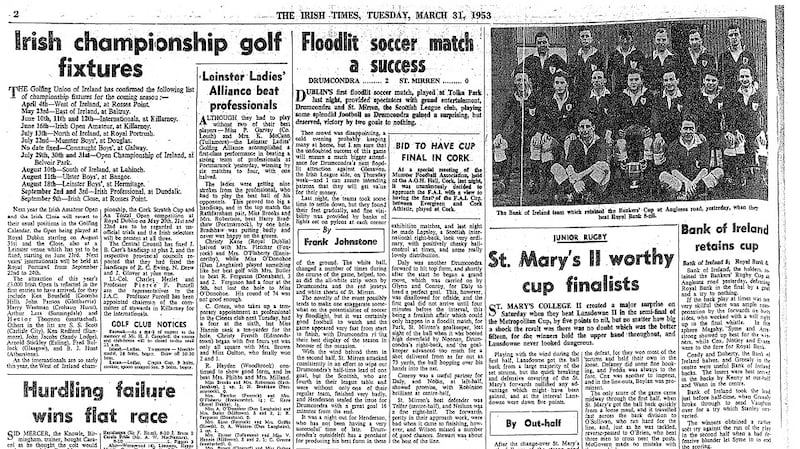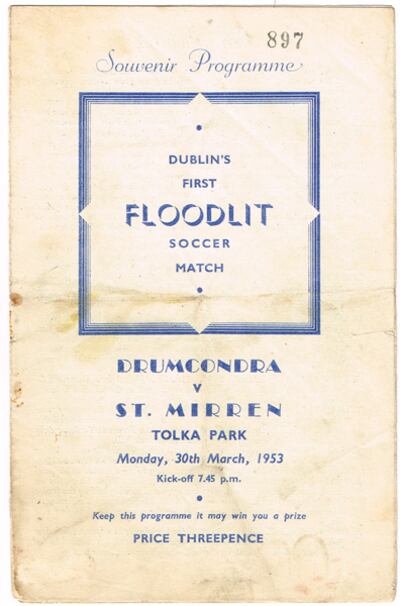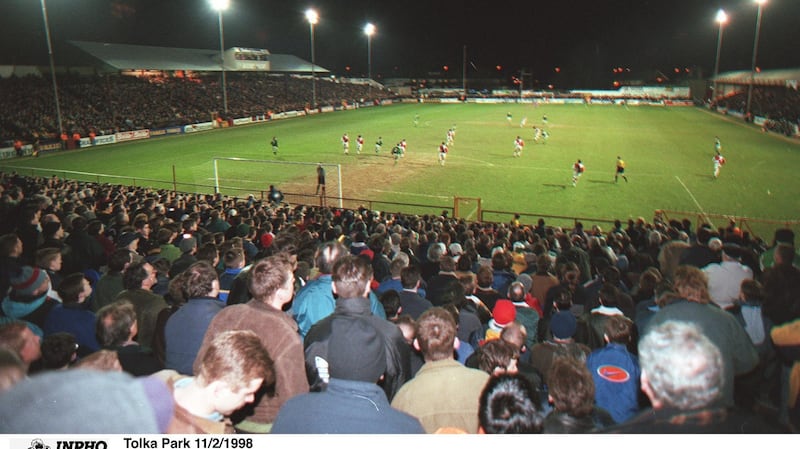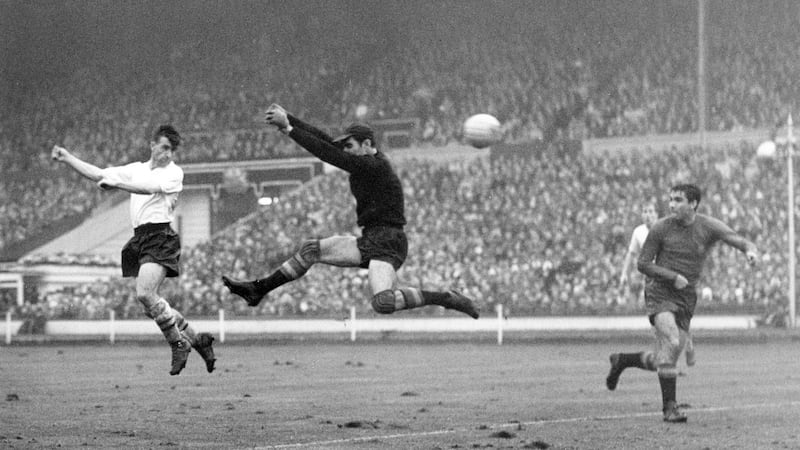“Dublin’s first floodlit football match, played at Tolka Park last night, provided spectators with grand entertainment, Drumcondra and St Mirren, the Scottish League club, playing some splendid football as Drumcondra gained a surprising, but deserved, victory by two goals to nothing.”
Those words, written by Frank Johnstone in The Irish Times on Tuesday, March 31st 1953, signalled a new dawn in Irish football which started 65 years ago this month. It was a change that would have a profound effect on players, supporters and, in some form, Irish society itself.
The Ireland of 1953 was a very different place to what it is today. World War II had ended eight years previously while rationing, which finally ended in 1951, was still, understandably, very fresh in the minds of the people.
Éamon de Valera was still taoiseach, Seán T O’Kelly was president, tuberculosis was still a rampant killer and the country that had declared itself a republic only four years previous.

On the football side of things, the international team were struggling to qualify for the 1954 World Cup but the domestic league was in quite rude health.
With no games from England on the television and a struggling international side, fans instead turned out to watch their respective League of Ireland clubs.
Shelbourne led the league table (and would indeed go on to win the league) with Drumcondra in close pursuit. St Patrick's Athletic's Shay Gibbons was the goalscoring maestro, netting 22 times in 22 games in the 1952-53 season while, further afield, Johnny Carey was the Irish football hero at the time as the captain of Manchester United.
Matches for those in Dublin were almost exclusively 3pm kick-offs on Sunday afternoon and were built into the routines of supporters. Sunday dinner followed by a trip to Milltown, Tolka Park, Dalymount Park, or Richmond Park. Football was to be played in the afternoon and at no other time. That was it.
But then along came Sam Prole, owner of Drumcondra and a man with a vision for a new era of League of Ireland football – one that would be played out under the glitz and glamour of bright lights mounted on 45-foot tall pylons.

Surely this couldn’t be done? It would take a complete change in the psyche of the Irish football supporter to attend a match in the evening after a hard day’s work.
Even in England there had only been experimental friendlies or representative matches played under floodlights at the Dell, home of Southampton, Sheffield United’s Bramall Lane, and a clash between Arsenal and Hapoel Tel Aviv at Highbury, to name a few.
It would not be for two more years – November 30th 1955 to be exact – before England took on Spain in the first floodlit international match at Wembley, although even that is a bit of an exaggeration as the floodlights were only switched on for the last 15 minutes. Four months later floodlights arrived in the Football League when Newcastle visited Portsmouth at Fratton Park.
Exciting time
But this was a time when Irish domestic football wasn’t nearly as far behind English football as it is today. In fact, it was in Tolka Park that football would be played under floodlights before it even reached the twin towers of Wembley.
"Pylons, 45 feet high, have been erected at each corner of the ground, with banks of lights on each one, the total lighting representing 60,000 watts, which use up one unit of electricity per minute," reported The Irish Times on Friday, March 20th, 1953.
Below was an ad for E. J. Ryan City Electrical Service – the company that had installed the lights – proudly proclaiming themselves as "the pioneers in this field". And they had much to proclaim about. Even the streets of Dublin were still mainly lit by gas lamps so to install electrical lighting at a football ground was no mean feat.

"It was a very exciting time for our family particularly," says Robert Prole, son of Sam and a former Irish amateur international himself.
“People didn’t believe you could play football under lights. While our lights weren’t the best in the world they were good enough to play under and quite a lot of teams played under the lights in Tolka.
“Distillery had lights in Belfast. We went up to Belfast – my dad, my brother and I – to see Distillery play (in a friendly against Burnley). They were the first team in the North to have floodlights and then we followed them down here.”
On St Patrick’s Day 1953, Sam Prole announced that Drumcondra would take on St Mirren in a friendly under those newly constructed floodlights on Monday, March 30th. The first competitive League of Ireland match under lights would follow a month later when Drums took on Dundalk.
“My father and my brother [Royden] travelled a lot and they believed in keeping up with the times and keeping up with what was new,” Robert Prole recalls. “When we took over Tolka then we decided we’d put in the lights and it would add to the place. My father had to borrow a lot of money for it at the time and with the help of friends and family we gathered it together and put them in and it made Tolka really.”
Sam Prole had been secretary of Dundalk since the 1920s after a broken leg in a match against Bohemians had ended his career. An avid football man who was a founder member of Dundalk having worked for Great Northern Railway, Prole took ownership of Drumcondra in 1952 from the Hunter family and installed his son Royden as director.
Retirement plan
Between them they planned to bring floodlit football to the League of Ireland. Not only would this set Drumcondra apart from other clubs but it would also make them more financially secure by hiring out the ground for other events under lights such as the boxing, athletics, gymnastics and wrestling that all took place at the venue in later years.
According to Robert, it was supposed to be a pretty elaborate retirement plan but turned out to be much more than that.
“He was going to lose his job because the Great Northern Railway was closing down. So this was his idea of keeping himself busy in retirement but I don’t think my mother would have agreed with that because he was never still for a minute!”
Described in his death notice in The Irish Times on June 28th 1975 as "a bigger than life football administrator for whom there was only respect and admiration," Sam Prole was one of the major players in Irish football at the time and would go on to become chairman of the FAI as well as playing a big part in bringing Pele and his Santos club team to Dalymount Park in 1972.

However, perhaps his biggest achievement in the game was bringing the light to Irish football. Nowadays, with virtually all League of Ireland football played under floodlights on Friday nights, it’s hard to imagine it being any other way.
However, in 1953, it was hard to imagine football being played at any time other than the middle of the afternoon. Indeed the attendance at the very first exhibition match between Drumcondra and their Scottish visitors was quite poor.
As Johnstone notes in his match report: “The crowd was disappointing, a cold evening probably keeping many at home, but I am sure that the undoubted success of this game will ensure a much bigger attendance for Drumcondra’s next floodlit attraction against Glenavon, the Irish League side, on Thursday week – and I can assure attending patrons that they will get their value for money.”

Elsewhere scepticism was particularly rife with many wondering how football could possibly fit into the evening plans of a regular, hard-working Dubliner.
As one reporter in the Evening Herald wrote: "The game under lights at Tolka Park on Monday was very fine from every point of view except for the attendance. The idea of going to a soccer match at night has to catch on in the manner of an acquired taste. Where will it all end is another matter. Perhaps, in ten years, we shall have the choice at night of the pictures, the theatre or a soccer game. Maybe the daylight game is on the way out, who knows?"
In the Cork Examiner (forerunner of the Irish Examiner) it was noted that players, as well as fans, would have to adjust to this new-fangled idea.
Successful start
“Floodlit soccer has the great advantage of enticing the supporter who has spent all day at work, and who might otherwise spend the evening at a film or in an hostelry, to come to Tolka Park at 8pm and watch the game for 1/6 or 2/-. Of course it must be realised that artificial light has its limitations, but players can adopt a technique to suit the conditions.”
Indeed those conditions played havoc in that opening game when the St Mirren goalkeeper was bamboozled by the lights for the first goal of the game.
"The first goal did not arrive until four minutes before the interval," reads The Irish Times report. "This was a freakish affair which could only happen in a floodlit match, for Park, St Mirren's goalkeeper, lost sight of the ball in the light when it was booted downfield by Noonan, Drumcondra's right-back, and the goalkeeper advanced too much for a shot delivered from as far out as 75 yards, the ball hopping over his hands and into the net."
Benny Henderson scored a second for Drumcondra 16 minutes from the end to seal the victory in the tie and mark a successful start to the era of night-time football in Ireland.
While the future of Tolka Park is now uncertain and the curtain could soon come down on the old ground, it’s worth remembering the time when it was at the forefront of the football world – even ahead of Wembley Stadium.












